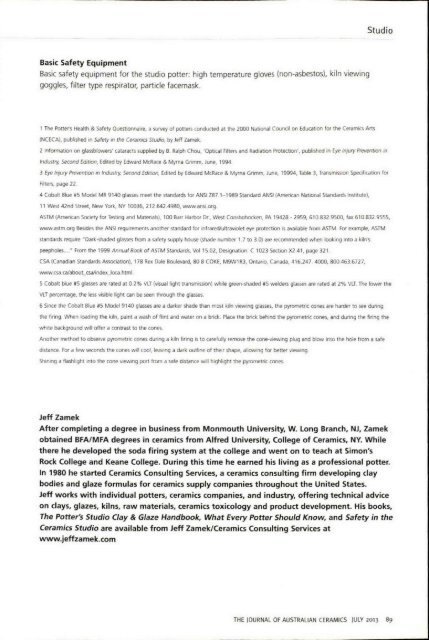The Journal of Australian Ceramics Vol 52 No 2 July 2013
You also want an ePaper? Increase the reach of your titles
YUMPU automatically turns print PDFs into web optimized ePapers that Google loves.
Studio<br />
Basic Safety Equipment<br />
Basic safety equipment for the studio potter: high temperat ure gloves (non-asbestos), ki ln viewing<br />
goggles, filter type respirator, particle facemask.<br />
1 <strong>The</strong> Polter's Health & Safety QuestIOnnaire, a survey <strong>of</strong> potters conducted at the 2000 National Coundl on Education for the <strong>Ceramics</strong> Arts<br />
(NCECA). published In Safety in the CeramICs Studio, by Jeff Zamek .<br />
2 Information on glassblowers' cataracts supplied by B. Ralph Chou, 'Optical Filters and Radiation ProtectIOn', published in Eye InjUry Prevention m<br />
Industry. Second Edition, Edited by Edward McRace & Myrna Grimm, June. 1994.<br />
3 Eye InjUry Prevenrlon m Industry, Second EdltfOO. Edited by Edward McRace & Myrna Gnmm, June, 19994, Table 3, rr3nsml5510n SpeCifICation for<br />
Filters, page 22.<br />
4 Cobalt Blue #5 Model MR 9140 glasses meet the standards for ANSI ZS7 1- 1989 Standard ANSI (American National Standards Institute),<br />
II West 42nd Stre€1. New York, NY 10036,212.642.4980, WWlNansi .org.<br />
ASTM (Amencan Society for Testing and Materials), 100 Sari Harbor Dr., West Conshohocken, PA 19428 * 2959. 610832.9500, fax 610.832 .9555.<br />
W'MY.astm.org Besides the ANSI requirements another standard for Infrared/ultraviolet eye protection IS available from ASTM . For example. ASTM<br />
standards require MDark*shaded glasses from a safely supply house (shade number 1. 7 to 3.0) are recommended when 100l(ln9 into a kiln's<br />
peepholes .... M From the 1999 Annual Book <strong>of</strong> ASTM Standards, <strong>Vol</strong> 15.02, Designation: C 1023 SectIOn X2 .41, page 321 .<br />
CSA (Canadian Standards Association). 178 Rex Dale Boulevard, 80 B COKE, M9W1R3, Ontario, Canada. 416.247. 4000. 800463.6727,<br />
WIIM'.csa.ca/abouCcsalindex.....loca .html .<br />
5 Cobalt blue #5 glasses are rated at 0.2% VLT (visual light transmission) while green~shaded #5 welders glasses are rated at 2% VlT. <strong>The</strong> lower the<br />
VlT percentage. the less visible light can be !teen Ihrough the glasses<br />
6 Since the Cobalt Blue #5 Model 9140 glasses are a darker shade than most kiln viewing glasses. the pyrometIic cones are harder to see during<br />
the firing. When loading the kiln. paint a wash <strong>of</strong> flint and water on a bffck. Place lhe brick behind the pyromelric cones, and durtng the firing the<br />
white background will <strong>of</strong>fer a contrast to the cones.<br />
Another method to observe pyrometrk cones dunng a kiln firing IS to carefulty remove the cone-viewing plug and blow into the hole from a safe<br />
distance. For a fe

















